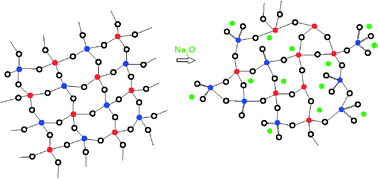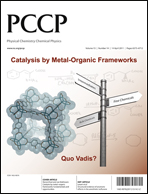The structural organization of sodium borophosphate glasses with composition (Na2O)x(BPO4)1−x (0.25 ≤ x ≤ 0.55) has been investigated by differential scanning calorimetry, Raman spectroscopy, X-ray photoelectron spectroscopy (XPS), as well as single- and double resonance 11B and 31P magic-angle spinning (MAS) NMR. 11B MAS-NMR data indicate the dominance of anionic four-coordinated boron units, and 31P MAS NMR reveals the successive transformation of neutral P(3) into singly charged P(2) units and their further transformation into doubly charged P(1) units at high Na2O contents. The quantification of these units provides detailed insight into the competition of the network formers borate and phosphate for the network modifier oxide. At low modifier content (x < 0.35), the anionic species are almost exclusively borate (B(4)) units, whereas at higher sodium concentrations, large numbers of anionic phosphate (P(2) and P(1)) species are formed. O-1s XPS data provide a quantitative distinction between B–O–B, B–O–P, and P–O–P linkages as well as non-bridging oxygen atoms, and comparable numbers can be extracted from 11B and 31P MAS-NMR experiments. Both XPS as well as 31P{11B} and 11B{31P} rotational echo double resonance (REDOR) NMR results reveal strong interactions between the two network formers boron oxide and phosphorus oxide, resulting in a preferred formation of B–O–P linkages. For higher Na2O contents, however, the successive network modification diminishes this preference, resulting in close-to-statistical network connectivities. Compositional trends of Tg in the Na2O–B2O3–P2O5 glass forming system can be correlated with the overall network connectedness, expressed by the total number of bridging oxygen atoms per network former species. However, separate linear correlations are observed for different compositional lines, indicating also the relevance of the type of network former linkages present.


 Please wait while we load your content...
Please wait while we load your content...